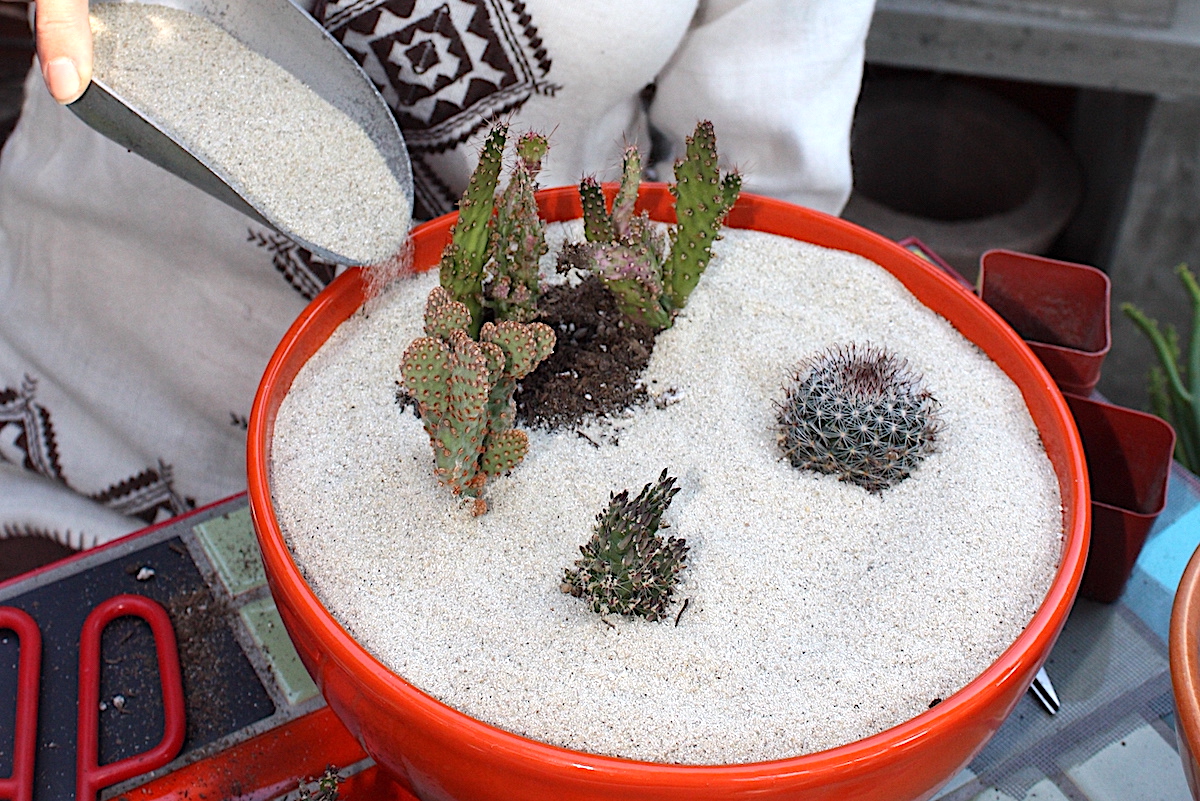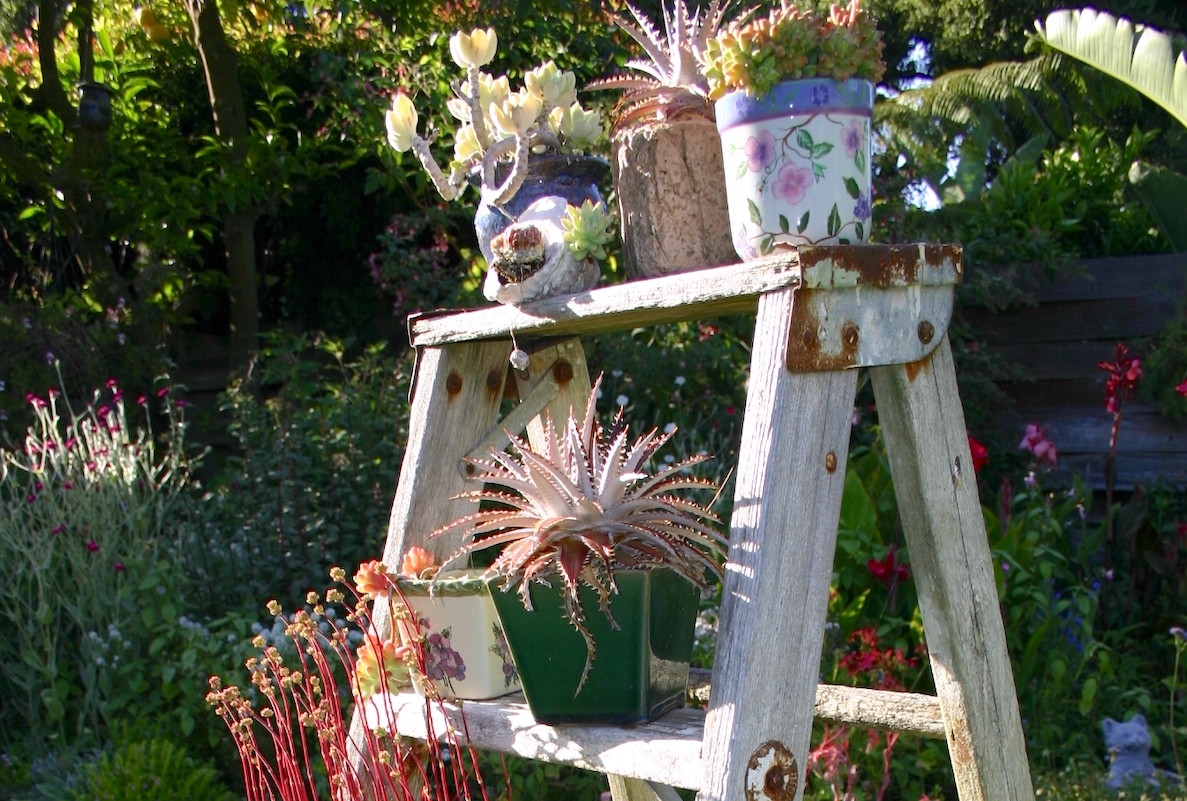
Succulent Plant Hacks
I love a good succulent plant hack---a clever solution to a common problem---especially if the hack utilizes something unexpected. I offer a dozen here.
If you have a hack, tip, or workaround that has to do with succulents, would you kindly share it in the Comments? Thanks!
Carry cacti with firewood tongs
Eileen Haag of Lakeside, CA notes that a friend who donated "some sections of fence post cactus" to a charity plant sale she was in charge of, transported them with "fireplace log tongs. They make handling the large pieces so much easier and safer than my bailing twine method," Eileen says.

Tongs shown here hold firewood, but also might transport a segment of cylindrical cactus (Amazon photo)
My fool-the-eye aeonium
Like me, you've probably had aeoniums that lean toward the sun, their rosettes nearly vertical atop horizontal stems.

My Aeonium 'Sunburst' rosette pretends to be a cut flower
This hack fooled visitors for two years: I placed a vase under the neck of a 'Sunburst' rosette. It looked like it had been cut and put in the vase, but from the side (see photo at top), it became obvious it was rooted in the ground more than a foot away. Ha-ha!
Watering hacks
How do you water a succulent that has engulfed its pot? If it's a spherical cactus, dribble water on the top. Ribs will channel water to the soil. Leaves of agaves and other rosette succulents also efficiently funnel water downward.

This barrel's ribs and spines saw to it water reached its roots. A little flowed out of the pot's drain hole, but none dripped off the plant.
Alternatively, set the pot in a pan with an inch or two of water. Via osmosis, it will go up through the drain hole and moisten the soil.
Topdressing tips
Another reason to water pots from below is to avoid disturbing fine topdressings like colored sand or criva (tiny pebbles).

Assorted topdressings for pots at Succulent Gardens nursery in Castroville, CA
Before adding a glass topdressing, first spread a layer of white sand or pumice. It'll keep the color of the glass true, and you won't have to use as much of the glass to get the desired effect.

White sand can serve as a topdressing or an under-layer for crushed glass.
Avoid breaking a nice urn
When planting a pot that has shoulders, keep in mind that roots will expand into the wide area below the neck. This hack shows how to avoid having to damage the plant and/or pot later on.

Terracotta pot with nursery pot as liner
I used a liner (cache-pot), a smaller second pot that fits into the larger. (It's one of many empty nursery pots I have kicking around.) You don't want the liner to slip down into the pot, yet it also needs to be easy to remove. The inner rim should be below the outer to conceal the liner, and the neck of the larger pot should hold the smaller snugly.
What did I plant in it? See below.
Plant-label hack
Naturally we all want to remember the names of our garden plants (guests will ask), but plastic plant tags crack and fade, and metal ones are pricey and hard to read.
Every year during the Laguna Beach garden tour, I look for rounded stones that that marvelous garden club uses to ID noteworthy plants.

Rock used as a plant label
What pen to use? Sharpie permanent markers or specialized garden markers won't fade and will work on any smooth surface.
This is what I planted in the "pot with shoulders" above. Senecio macroglossus (wax ivy) is a name I can never remember, hence the labeled stone on the rim. The plant cascades like ivy over time.

Senecio macroglossus (wax ivy) will cascade over the sides of the tall pot. I used a pea-sized bit of earthquake putty to secure the labeled stone to the rim.
Alternatively, coat one side of flat oval rocks with acrylic paint. Let dry and add the plant's name in a contrasting color.
Disguise white objects
No color jumps out at you in a garden as much as white. (Red is next; black is last.) Pay attention to how, in photos of your garden, white draws attention.

Which pot in this grouping stands out the most? Hint: Purr.
Use white wisely: either feature it or make it disappear. If you can't remove a small but offending object like an irrigation riser, spray it with camouflage paint.

Before (left) and after (right): white riser I spray-painted brown
Don't like corking? Paint it!
Tall cacti and euphorbias are prone to corking---brown patches that suggest disease or damage but actually are woody tissue.

Look closely: Jim Bishop, whose famed San Diego garden often is on the annual Mission Hills Garden tour, painted areas of corking on an Euphorbia ammak 'Variegata' near his front door
If you find corking unsightly, paint over it to match the plant's skin. Waterproof acrylic won't harm the succulent...and, for that matter, neither does corking.
Tumble-safe pots
Decide where you want pots to go on a shelf or wooden step, then mark where their drain holes will be. Pound large galvanized nails, one per pot, into each spot. Nails need to be secure and have several inches sticking up. Anchor each pot on the top part of each nail through its drain hole.

Flower pots at risk of falling? Use finishing nails to hold them in place through their drain holes.
A fix for floppy shrubs
I use the next hack for shrub aeoniums, cotyledons, ice plants and senecios. It's an alternative to the conventional way to tidy floppy, untidy succulents (which is to pull the plants out and use their top growth for cuttings).
Think of it as planting cuttings while they're still on the succulent: dump a bag of potting soil onto the plant to cover its naked, branching stems. Nodes on stems will send roots into the soil and ensuing new growth will fill gaps. Watch me do it in the video above.
For a quick aesthetic fix, tuck a few cuttings into the mound of soil. Water to settle it and to rinse off accidentally buried rosettes.
Speed up slow plants
When you want a super-slow potted succulent like Agave victoria-reginae to grow faster, here's a tip from members of the CSSA (Cactus & Succulent Society of America): Plant it in the garden.

Agave victoria-reginae (and most succulents for that matter) grow faster in the ground
Roots with room to spread more rapidly fuel top growth. When the plant attains show-quality size, transplant it into a worthy pot.
Use lizard ladders

I keep critters from getting trapped inside empty nursery pots with "lizard ladders."
If you, like me, keep empty nursery pots, you risk trapping lizards. They get in but can't get out because of the pots' slick plastic. I place a small branch or wood stick in each pot so the critters can climb out...and (eew) I don't have to remove desiccated remains.
My echeveria-hummer hack
Blooming robs echeverias of energy and can make rosettes lopsided. Nurseries routinely remove echeveria flower stalks to preserve the plants' vitality and symmetry.

Hummers will visit echeveria flowers in a vase as readily as those on the plant.
Because hummingbirds love them, I place echeveria bloom stalks in a large vase or bucket of water near the plants. Buds continue to open into lantern-like flowers, and---because stems are succulent---they last as long as those on the plants.
YOUR turn!
Got a favorite succulent or gardening hack? I'll bet I'm not alone in wanting to hear about it. Do share it in the Comments below. Thanks!
Related info on this site
Potted Succulent Tips and Hacks
Garden Gate shows ten of my tips and hacks for potted succulents. However, the magazine didn’t have room for all the ideas I sent. So, for your enjoyment and edification, here are the rest.
15 Thrifty Tips for Low-Water Landscapes
My 15 simple, economical fixes for a 2-1/2 acre Santa Barbara wedding venue emphasize succulents and apply to any low-water, mild-climate landscape.



What a wonderful post! I love garden hacks.
Hi, maybe I didn’t read thoroughly enough, but another way to anchor pots without using nails is to use a bolt, washer and nut assembly. They can be easily moved then if necessary .Maybe leave it slightly loose for drainage. I’ve thought of it but never tried it. My next thought which I am currently testing is hanging terracotta/clay, non plastic pots. They are weighty, so I took a circumference of garden hose enough to fit just under the pot’s larger rim part. Connect the hose with an old-fashioned doll head style clothespin, like for a coupling. Then you can decide how to hang it, with a triad of wire, rope…? I like hanging pots but not plastic hanging pots.
Oh! That makes much more sense (the bolt-washer-nut idea). You can tell how non-handy I am. Will revise the text. And Audrey, if you come up with a way to hang pots that doesn’t involve a coir- or moss-lined wire basket, I’d love to know. Every year nesting birds strip my hanging pots down to the wires, leaving a mound of soil and plants clinging to life. I do leave nesting material out for them, but no, they’d rather have the pots.
Wrap your hanging pot liners in burlap to make them last longer. Pull diagonally on the corners of the square and fold the fabric into the planting area.
I saw this on an old TV show of Martha Stewart.
Hm…pretty sure I have burlap around here somewhere…but I wouldn’t put it past my garden’s nesting birds not to pull it apart, too! I’ve got three or four hanging baskets that need redoing because there’s no liner left.
Thank you for the wonderful hacks! I just sighed when I saw the echies throwing up blooms because it looks so messy. Love your idea of putting them in water. You are so very helpful, and I appreciate all your hard work to share your knowledge. Best holiday wishes to you and yours.
You sweet thing! Thank you, Susan!
Wonderful article. Not only is it useful, some of the hacks prove that you really care for the plants and even for the critters.
Indeed I do. My dad was keenly aware of the natural world, something I took for granted about him. Now I really appreciate how he opened my eyes to everything from insects to stars. Your comment gave me a sweet reminder of him—thank you!
Thank you for this post! My favorite is the Echeveria flower hack: I’ve been putting up with a disfigured plant when I want to enjoy the blooms. I’m definitely going to try this next time! How far along do you let the buds develop before cutting the inflorescence?
Unfortunately, like you, I learned the lizard-ladder hack the hard way. 🙁 I also learned to never, ever use a sticky rat trap in the garden. At least I found the poor lizard victim while he was still alive, but it took me the better part of 2 hours to free him and clean the sticky goo off his feet (q-tips & warm water- I was afraid of using soap or anything stronger for fear of hurting him further).
Also, if I may comment- it’s not osmosis that will draw water into a pot from the bottom, it’s capillary action due to pore spaces in the soil matrix coupled with the surface tension of water, along with water’s adhesive and cohesive forces. Osmosis is a very different process. Hopefully not too geeky. 🙂
Hi Mike — Hm. Capillary action…good to know. Not too geeky at all! You describe it very well. I got this off the Internet just now: “In biology, osmosis is the movement of water molecules from a solution with a high concentration of water molecules to a solution with a lower concentration of water molecules, through a cell’s partially permeable membrane.” The way raisins plump is an example, as is the way our fingertips get wrinkly when in water for awhile.
I wait to cut an echeveria bloom stalk until it seems to have stopped growing, buds have formed, and a few have opened. Those that have yet to open continue to mature even after the stalk is cut. (Though now I’m wondering if severing the stalk lessens hydraulic pressure needed to open all the buds.)
I know. Those sticky traps seem like a good idea, but once something gets stuck in them, it’s doomed to a slow, ghastly death. I can’t believe the box says they trap snakes…shudder… How wonderful that you were so determined to free the victim that you spent two hours doing so! Birds hop around on the ground, too. I’m still grieving a Bewick’s wren that got caught in a mousetrap.